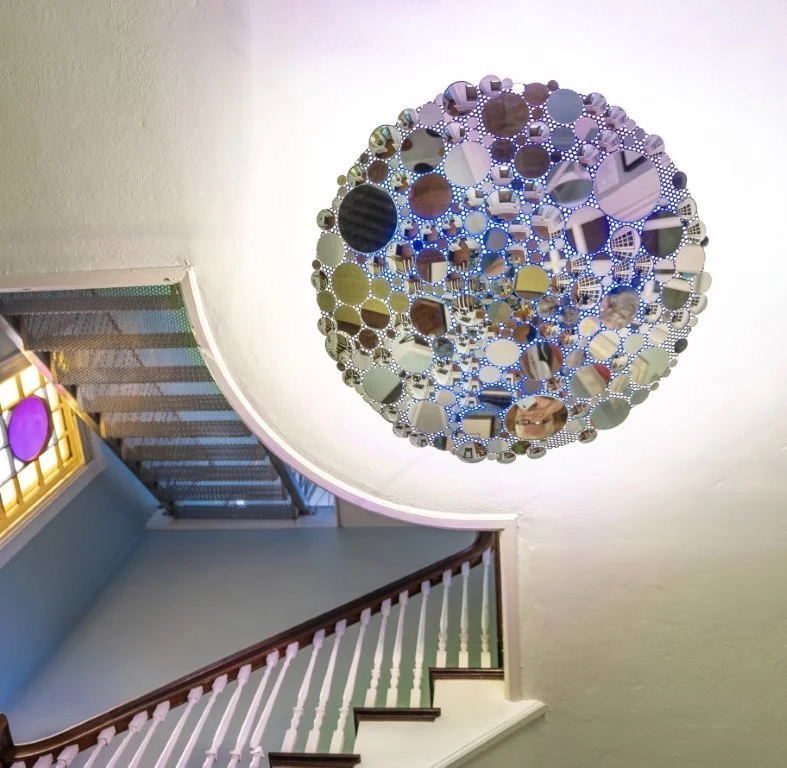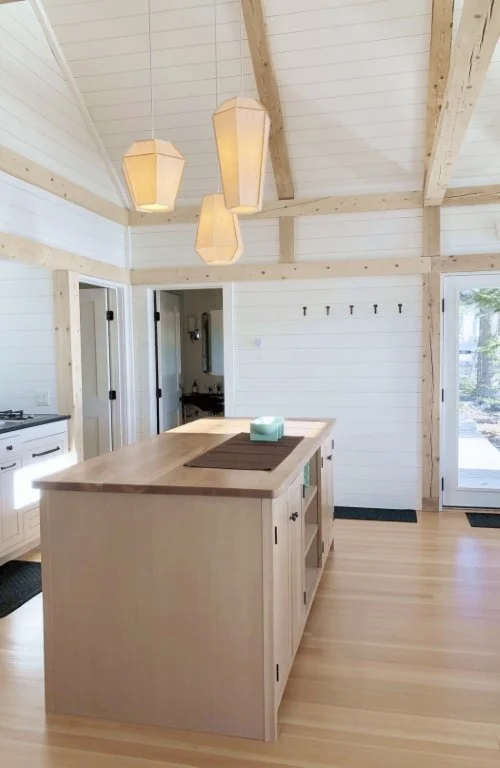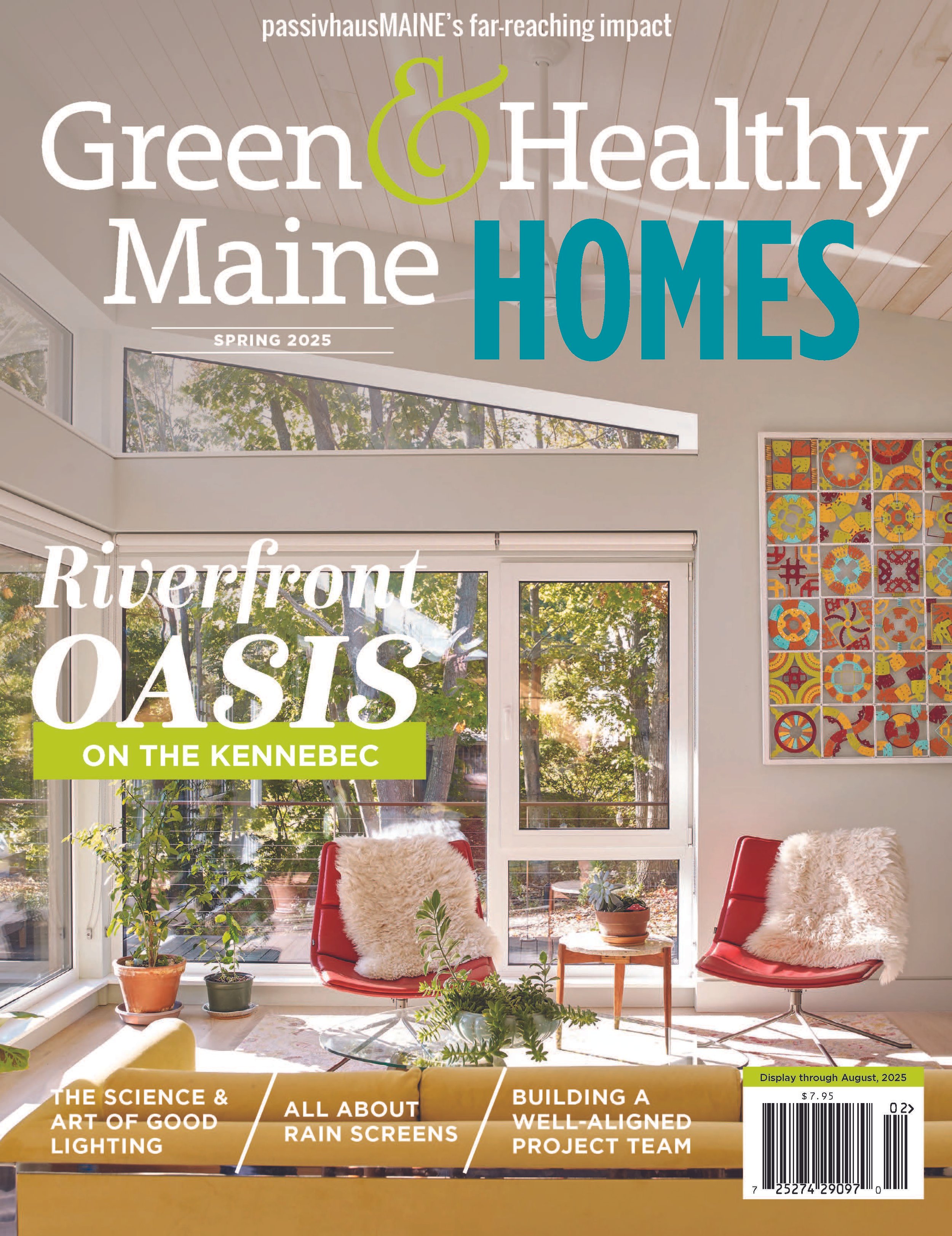The science & art of good lighting
A custom lighting installation by Ember Grove. PHOTO: LISA FERREIRA JONES
By Amy Paradysz
Better lighting isn’t just about more lighting but more thoughtful lighting.
To get a sense of what that means, imagine the opposite: Would you like your home lit up like the perpetual high noon of a hospital?
I sure wouldn’t.
When asked about tips for good residential lighting, designers Emily Gorecki, Grace Rote and Greg Day all emphasized the connections between lighting and our bodies’ internal clocks.
“From prehistoric times when we’d huddle around a fire, we’ve been programmed for that amber glow, which loops into our circadian rhythm,” says Gorecki, president of the Portland chapter of the Illuminating Engineers Society.
Over the past millennium, we’ve shifted from a total reliance on sunlight and firelight to incandescent light (that gave us more control) and more recently to LEDs (that gave us a lot more energy-efficiency in addition to control).
A custom "mirror spore" lighting element by HEMESphere. PHOTO: JOE HEMES
New light fixtures are typically LED-based and some can even can be programmed to shift color to better match our circadian rhythm—“cooler in the morning to mimic early light and warmer and more calming in the evening,” explains Rote of light + form studio. Remember that perpetual noon of hospital lighting? A recent Greg Day Lighting residential project for a healthcare worker involved setting lights to change from cooler to warmer tones from day to night as a visual cue to help resync her at-home sleep cycles.
In addition to those subtle shifts in color, LED fixtures can be set at different vibrancies for different purposes. For example, you might want bright task lighting where you shave your beard—and the option to dim those lights when nature calls in the middle of the night.
In addition to the color and vibrancy of light, “layered” or “integrated lighting” can help spaces feel more natural or welcoming.
Rote explains: “When people think of residential lighting, they often think of downlights. But what if instead of four downlights in a living room we have two downlights and two wall washers? This creates a more comfortable atmosphere, because the wall becomes a light-reflecting surface.”
Layered lighting feels more natural because it replicates how we perceive the light from the sun, which is rarely at its zenith. On a subliminal level, light that is always directly overhead, always the same vibrancy, and always the same color doesn’t feel authentic.
The good news is that replicating that authenticity with LEDs is getting more and more within reach. “Technology is catching up,” Day says.
Clearly, lighting design leans on science.
But it’s also an art.
In fact, several Maine artisans have made lighting elements and illuminated sculptures their life’s work, pursuing forms and techniques that not only help us see but help us see beauty. Here are the stories of four such makers—inspired by the warm glow of burning embers, by organic shapes, by the islands and mountains of Maine and by a need to start conversations about global warming.
Lisa Ferreira Jones added Maine pearly everlasting flowers to the paper for the shade for this table lamp with a maple base. PHOTO: JAY YORK
Ember Grove
Handmade papers and custom lighting
Back when she was a student at Maine College of Art, Lisa Ferreira Jones photographed her handmade wire-and-paper lanterns lit in the woods, which is how she got her business name Ember Grove. “I really liked the idea of glowing embers in a forest,” she says. “A warm glow is so comforting.”
In her garage studio in Falmouth, Jones’ freeform sculptural lamps look like a cluster of softly glowing mushrooms that sprung up naturally. This organic style has a lot to do with Jones’ process, which begins with foraging. She adds seeds and silken bits of Jerusalem artichoke, milkweed and pearly everlasting into the paper slurry, creating interesting textures that add visual interest when illuminated.
“I love how the golden color from the pollen seeps out of the Jerusalem artichoke,” she said.
In addition to papermaking, Jones’ work is a blend of metalsmithing, electrical wiring and basic woodworking. Downed oak, beech and maple saplings receive a second life as rustic lamp bases.
“My pieces are functional and bring a little bit of nature indoors so that you can be inspired by that and interact with it every day,” Jones says. “Almost everything I do is custom. I often go in people’s homes and bring all my color swatches. They take the time to pick what they want as a special piece— art that they’ll have for a long time.”
There’s no top or bottom to these scored-and-folded maple veneer lamps by Modernmaine; either way works. PHOTO: JULIE MORRINGELLO
Modernmaine
Illuminated sculptures
Is it a light? Or is it a sculpture?
Both, though some lean more one way or the other, says Julie Morringello, the creative mind behind Stonington-based company Modernmaine.
She starts with flat, floppy sheets of engineered wood—certified by the Forest Stewardship Council as sustainable—and shapes them into semi-translucent geometric structures perfect for contemporary-style lighting.
“The structural techniques I use—scoring and folding—are much like what you’d do with paper,” Morringello says. “These pieces are very light. Even a sculpture my height would be, probably, only 2 or 3 pounds.”
Customers choose from one of several patterns, most of which have a variety of customization options, including size and scale, type of wood, digital printing and color matching. For people who enjoy switching things up, some Modernmaine illuminated sculptures can even be hung upside down with no rewiring.
The popular Persimmon exhibits Morringello’s design thinking. First, the fruit-inspired shape and name are appealing for use in a kitchen. Second, the maple sheet is used in a way that lets a lot of light through both the acrylic diffuser and the staves, or wood strips, which works well over a table. Finally, the Persimmon is designed for compact shipping resulting in a smaller carbon footprint.
“You receive the core, which is wired, and a stack of wood staves that attach to the core,” Morringello says. “Assembly is easy. You don’t even need tools.”
For sustainability, all Modernmaine pieces are designed to be used with LED bulbs and are shipped with recycled or reused materials.
This Loten lamp, dubbed Mr. Right, pulls from a variety of styles and aesthetics, most notably art deco. PHOTO: STUART LOTEN
Loten Art Lighting
Hand-painted silk shades
For Stuart Loten, who started off making ceramic lamp bases, a bland lampshade just wouldn’t do. So he started painting his own. Half a century and thousands of lamps later, it’s safe to say this Montville-based artisan has found his niche with his hand-painted silk shades.
“When the light shines through, there’s almost a stained-glass effect, especially where there’s a layering of dyes,” Loten says.
Think back to art class and imagine drawing shapes with black crayon, then painting with watercolors. The crayon resists the watercolor. That’s the basic idea of the French technique called Serti, which means “fence” or “enclosing,” that Loten uses on his silk shades. He outlines the shapes with black gutta, a glue-like substance derived from latex. Once that dries, he turns to watercolors, mixing hues by layering and blending within the gutta outlines, creating that stained-glass look.
Loten’s one-of-a-kind shades come in three main aesthetics: island and mountain landscapes and botanical abstractions.
“The landscapes are recognizably Maine,” he says. “The island is a classic Maine island, just not a particular one. Same with the mountain scenes with pine and spruce trees.”
Though Loten long ago stopped working with ceramic, he still make the lamp bases—welding many of them from steel, copper and brass with botanical details. He makes floor lamps, table lamps, chandeliers, pendants, sconces and night lights. But one of the most notable lamps has to be the one he named “Mr. Right,” because, as he says, “it’s the lamp for anyone.” This welded table lamp has an art deco-inspired aesthetic, capped with a silk shade with a freeflowing botanical design.
HEMESphere’s illuminated sculpture called Dowsing Piper imagines a future bird with long legs evolved due to rising seas and many legs to run ever faster. PHOTO: JOE HEMES
HEMESphere Design
Sculptures, illuminated
On the spectrum of “is it a lamp” or “is it a sculpture?” Joe Hemes falls on the sculpture side.
“I spent 30 years as an architect and became uninspired by light fixtures and decided to design my own,” explains Hemes, whose company is fittingly named HEMESphere Design. “My goal is to create some magic with light.”
Hemes has occasionally worn both his architect and artist hats on the same project, as was the case at Coffee By Design in Portland, where HEMESphere’s 7-foot Tri-Zeppelin floats above the counter, illuminating the baristas’ workspace and coordinating with the coffeehouse’s burnt orange-and-gold color palette. Like other pieces in Hemes’ Zeppelin and Tri-Zeppelin line, it is structured with wire mesh, covered with fabric and colored paper, and illuminated with LEDs.
Since retiring from architecture three years ago, Hemes continues to focus on telling the story of global warming through sculpture. There’s a humor to his work that helps that hard medicine go down easier, so to speak.
Within HEMESphere’s Future Birds series, for example, there’s a 20-inch tall Dowsing Piper evolved to have “many long legs for better mobility on their beach habitat with rising oceans” and two heads with a dowsing bill to “divine food locations in marginal ecosystems.” This boxwood and maple sculpture is underlit with a blue watery light. It’s definitely a conversation starter.
“I need to tell the story about global warming, which until recently, was happening so slowly that it wasn’t getting a lot of attention,” Hemes says. “Many people are so busy with the immediate and don’t think far enough into the future.”
This article appeared in the Spring 2025 edition of Green & Healthy Maine HOMES. Subscribe today!
Find Maine experts that specialize in healthy, efficient homes in the Green Homes Business Directory.







